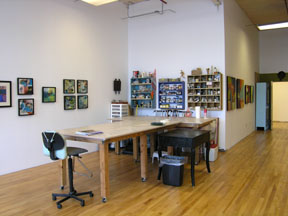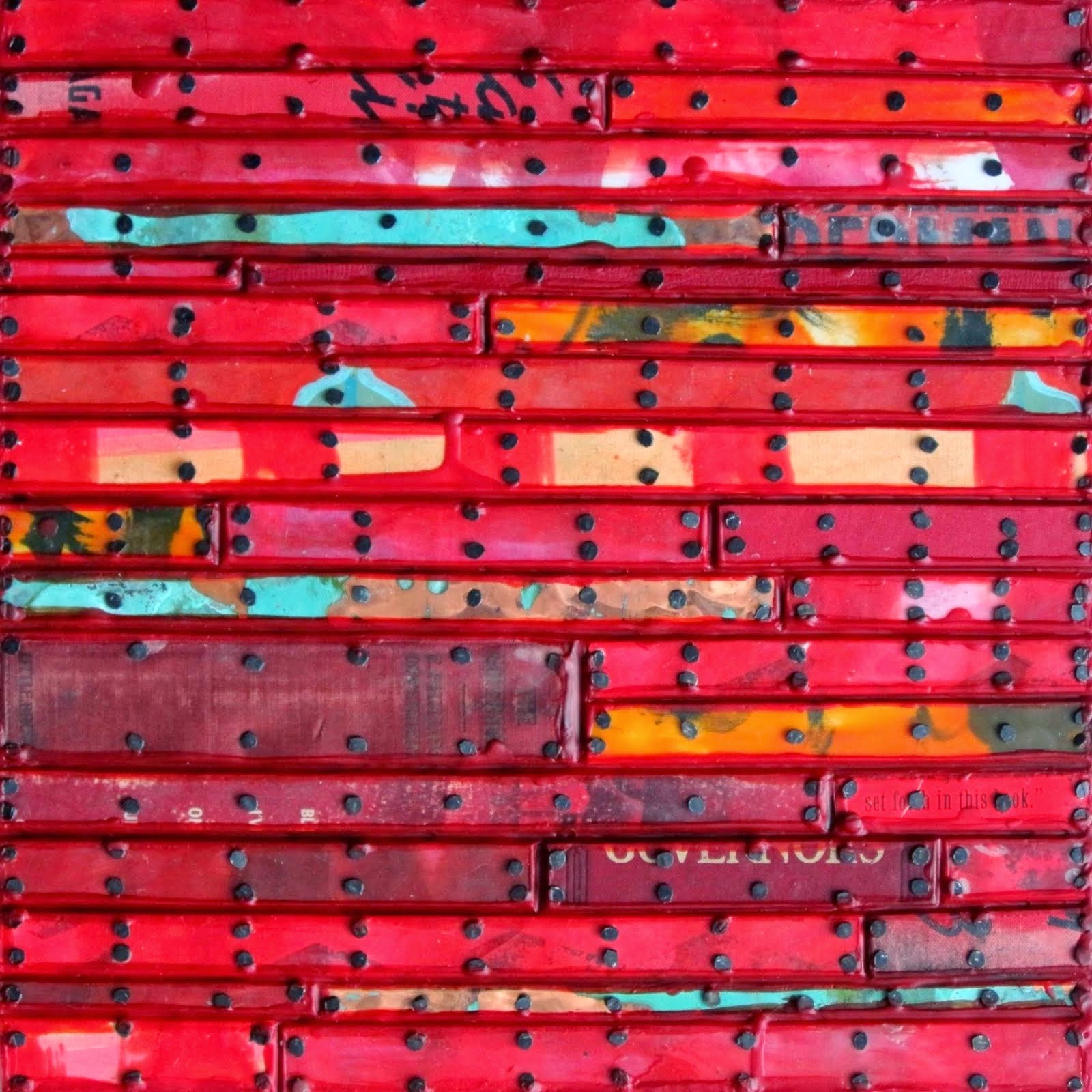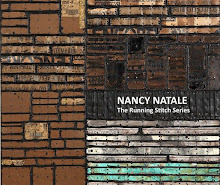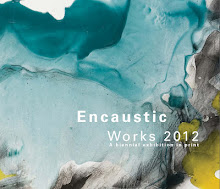 |
| Kim Bernard at the beginning of her mold making workshop |
The week of workshops held after the encaustic conference at the Truro Center for the Arts at Castle Hill (the "post-con workshops") are a great opportunity to pick up some new techniques or skills firsthand from specialists. I was really happy to see that Kim Bernard was doing a one-day workshop on making plaster molds for casting wax and signed up right away.
I do not use either plaster or cast wax in the work I'm making currently, but it never hurts to learn something that may rattle around in your mind for a while and be useful some time in the future. I started out thinking that I was really more interested in the plaster objects than in those made out of wax, but I have to admit that the wax objects are pretty alluring.
 |
| Kim with a big bag of plaster |
Plaster
Before we began making molds, Kim explained about plaster, also referred to as plaster of Paris, but sold as "gypsum plaster" in large paper bags. It can be bought in small sacks or plastic containers in hardwares or home stores, but is much less expensive to buy by the bag. It's important to store it in a dry place as once moisture reaches it, it will harden and become unusable. If you can store it in a sealed plastic bucket, it will probably stay more moisture free.
The way it's mixed is to fill a flexible plastic container about half full with cold water and then add plaster to it by the handful, crumbling each handful into the water to eliminate any lumps.When the dry plaster builds up enough to be visible on the top of the water, you stop adding more and let it sit without stirring or jostling for about five minutes until it sets up. After that you begin slowly stirring it with one hand so you can feel the viscosity change.
 |
| Here Kim has just added the first layer of plaster over the clay object she is molding |
One-Part Molds
We began with the simplest type of mold - just one part - and made on a simple object with no undercuts. For this we used clay to model an uncomplicated shape. (Note that we did not use the artichoke that I brought which was way too complicated even for a two-part mold.)
 |
| As the plaster becomes thicker and thicker, it is smoothed onto the object |
 |
| The plaster is built up to about 1" thick over the object and then flattened on the top so that it will stand flat when it's turned over. This is Kim's lovely mold. |
 |
| This is my awkward-looking mold. |
Once this process is completed, you have to wait for the plaster to finish hardening. It becomes quite warm as it hardens and must cool down before continuing. This took maybe 20 minutes or so.
 |
| Here Kim is showing the inside of the mold after removing the clay from it |
 |
| Kim scrubs the mold with a toothbrush to remove traces of clay and then lets it sit submerged in the water for five minutes or so |
The mold is saturated with water so that the wax is less likely to stick to it and will separate more easily.
 |
| Here Kim has positioned and shimmed the mold so that it lays flat and she has ladled wax medium into it. (Photo courtesy of April Nomellini.) |
 |
| This is the molded wax object. (Photo courtesy of April Nomellini.) |
After the wax is ladled in, it is left to cool and will harden from the outside in. You can either let it cool entirely so that it forms a solid object or you can stop the process when the wax shell is 1/8 to 1/4 inch thick by pouring off the excess wax from the middle.
We all completed this process with the objects we formed from clay, making the one-part mold and casting it in wax.
 |
| My one-part mold and the wax cast |
 |
| Our class was held outdoors in "The Shed" |
 |
| A broader, more tilted view |
Two-Part Molds
 |
| First part of the clay mold for a banana. At the stem end of the banana is a funnel-shaped piece of clay that will become a pour spout. |
Once you have made a one-part mold, you can easily move to a two-parter because the process is the same and it's not even twice as hard. This time the clay is shaped around an object, leaving about an inch beyond it and building up a little wall around the edge (see above). A pour spout is made at a good spot for wax to flow into the mold and three or four impressions are made in the clay that will be used for registration. The most important part of the two-part mold is deciding where the line will be where the two parts come together to form the wax object. With a banana that line is pretty easy to decide.
Now here's where I had to call in reinforcements: I spaced out on the next step in the two-part mold and got in touch with Sherrie Posternak, who had been in the workshop with me. Sherrie kindly filled in the blanks for me and sent me a bunch of great pictures.
 |
| Applying a release agent to the banana (photo courtesy of Sherrie Posternak) |
This is a step I forgot. You have to apply a release agent (liquid dish soap with 1/3 water) so that the plaster doesn't stick to the object you are molding.
 |
| Plaster is added in stages as with the one-part mold - first quite liquid |
 |
| The plaster is built up to about one-inch thick over the object and left to cure until it cools down |
 |
| Once it is cool, the clay is removed, exposing the object surrounded by one side of the plaster mold. |
 |
| The mold is cleaned up with a tool called a "sureform" and the other side is prepared |
 |
| Here's another one of Sherrie's photos showing the mold prepared for receiving plaster |
The photo above shows the first part of the mold and the banana coated with two or three applications of release agent, with the funnel-shaped pour spout remade and in place, with a couple of edges built up with clay and with clay shims underneath so that the mold sits flat on the table.
 |
| Next plaster is applied in stages until the mold is built up to about one-inch thick |
 |
| Here's the two-part mold curing as we wait for it to cool (Sherrie Posternak photo) |
 |
| When ready, the mold is cleaned up again with the sureform (especially the seam edge where the two parts come together) and then the two parts are carefully pried apart with a bread knife |
The object being cast (the banana) is removed when the two parts of the mold are separated and then the mold is placed in a bucket of water, cleaned up with a toothbrush and soaked if it's being cast right away.
 |
| Here the two-part mold is ready for wax to be added (Sherrie Posternak photo) |
This sounds like a lot of work, but the molds can be reused to cast multiple wax objects.
Apparently neither Sherrie, April nor I took a photo of the cast banana. It may not have been cooled enough to remove from the mold by the time the workshop ended, or maybe we were all distracted by the face casting which went on at about the same time the two-part mold was being filled.
This was a good class with a lot of info and I will use this post to follow the process if and when I use it.
A Final Note
Because my two-part mold was not ready to take apart at the end of the workshop and I was hurrying to clean up so I could get in to hear Joanne's talk about Wax in the Galleries, I never separated the two parts of my mold and removed the banana.
 |
| My two-part banana mold |
Many thanks to April Nomellini and Sherrie Posternak for providing photos and info.








7 comments:
Dang Nancy, I took notes but thanks to you I only have to go to this post on your blog. Thanks for the really great synopsis. I left that day as you did with the banana still in the mold. When I got back to the cottage where we were staying I did break it open. I thought it would be a bear to get apart but once I found where the two pieces came together it took a moment of concentrated strain and I must admit I was doubtful but it then easily came apart and I got that banana out lickity split. I let it dry some and wrapped it in a 2 days after for it's long ride home. So it is now sitting in the studio and I'm planning on trying it out Saturday. I'm looking around the house for my daughters toy ladle (from about 30 some odd years ago)but I have lost track of it since the move. Durn it would be perfect. Anyway blue banana Saturday. One question all of you from the class can help. In the post you say soak the mold if you are going to use right away. I thought you had to soak it anytime you are going to cast. Thanks again.
Wow! Thanks for the thorough step-by-step on making molds. Takes me back to my days as a potter, but your method is more accessible and low-tech than those I learned way back when. Can't wait to see what you do with this. Hopefully in 2012 I will be able to attend one of the post-con workshops.
This just in: Artist knocked unconscious by exploding device in Western Massachusetts.
Homeland Security had been called initially, but upon learning the "device" was in fact made of fruit and clay--"a sculpture mold, for godsake," said the FBI agent who led the inquiry--it turned matters over to the local medical authorities.
"It was a gaseous banana that knocked a woman unconscious," said the EMT on scene. He described the locaton as "maybe an artist's studio but so full of wax I couldn't really tell."
The artist, who suffered contusions, collusions and delusions, and has not yet been identified, was taken away on a stretcher. Though disoriented, she was heard muttering, "Read the blog post. Read the blog post."
LOL Joanne! So, that's what going to happen to my studio? As well as Nancy, I haven't open my banana mold yet. Oh no!!! I better hurry up and open it before it explodes!!!
Karen, yes, you have to soak the mold every time you want to cast, so the wax doesn't stick to it.
Nancy, thank you so much for the wonderful summary!!!!
Thank you, Karen, Jane and Corina for your comments. I'm glad you enjoyed the post. Joanne - I know you more than enjoyed it!
Thanks Nancy. I vaguely remember this process from earlier life but your clear photos make it something I'll try this summer.
Thanks, for sharing such a nice information, while writing a comment. These points is very useful, while we have to write comment for getting back-link.
This is a very good article.
Post a Comment